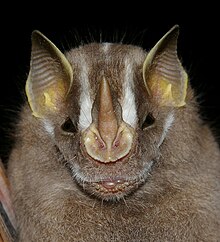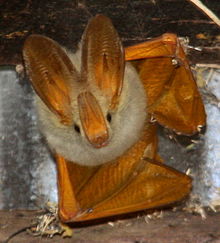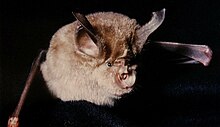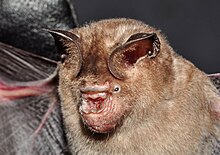Nasal sheet
As a nose leaf fleshy are flaps of skin on the noses of many bats called. The nasal blade is an important identifying feature for many species and is likely an adaptation to echolocation through the nose rather than the mouth.
function
All bat families with leaf-like modifications of the nose echolocate through the nose. Bats without a nosepiece, such as the smooth-nosed bats , echolocate through the mouth. It is believed that the nasal blade, similar to a satellite dish, bundles the echolocation calls and helps direct them in a certain direction. This is supported by new, functional studies on the horseshoe-shaped nasal blade in representatives of horseshoe bats such as the great horseshoe bat ( Rhinolophus ferrumequinum ) and Rhinolophus formosae . The resulting echo gives the bat precise information about its environment and possible prey. The nasal blade also reduces the pressure in the nasal cavity that occurs during echolocation through the nose.
A common theory is that echolocation through the nose has developed as an adaptation to the vegetarian diet of many Neotropical bats, which often carry fruit from the tree to a hanging place and during this time could not send echolocation calls through their mouths. The nasal leaf is therefore particularly prominent in the neotropical bat family of leaf noses , within which many types of fruit feed. However, this does not explain the less pronounced and nonetheless present nasal leaves in families such as the large-leaf noses , the horseshoe noses , the round-leaf noses and the slit noses , which all feed on insects and still echolocate through the nose. In addition, just as many leaf noses feed on insects instead of fruits. The nasal blade is therefore probably the result of a convergent evolution and not a single cause. Rather, nasal structures seem to have formed several times in the course of the evolution of bats . Interestingly, there are also recent species that echolocate through the mouth, and yet have rudimentary nasal structures that are reminiscent of the beginnings of a nasal leaf, such as the desert bat , representatives of the long-eared bats , the pig- nosed bat or mouse-tailed bats . These types have bulging elevations above the nostrils, but are not among the types that have an actual nasal sheet. However, nothing is known about a possible function of these structures.
Occurrence
Nose leaves are found in bats of the following families:
- Leaf noses (Phyllostomidae): The nasal leaf of thisfamily,which occurs in the neotropics, is usually a lance-shaped outgrowth directly above the nostrils, which is longer than it is wide and tapering to a point. The three types of vampire bats (Desmodontinae), which instead of the nasal blade have U-shaped pads that resemble a horseshoe, are anexception. These balls contain infrared-sensitive receptors with which the vampires can more easily track down the veins in their prey.
- Large-leaf noses (Megadermatidae): Representatives of thisfamily,which occurs in Asia and Africa, have similar nasal leaves as the leaf noses, which are restrictedto the neotropics . However, this is usually rounded at the tip and not tapering to a point.
- Horseshoe bats (Rhinolophidae): The nasal blade of this family is more complex than that of the leaf noses and large-leaf noses , and usually consists of several flaps of skin surrounding the nose. The lower part is horseshoe-shaped, covers the upper lip, surrounds the nostrils and has an indentation in the middle. A leaf-shaped structure rises above the nose, which is designed differently depending on the species. There is a saddle ( sella )between the horseshoe-like structure around the mouth and the actual nasal sheet
- Round-leaf noses (Hipposideridae): Similar to the horseshoe bats , the nasal blade is also relatively complex in this family. Around the mouth there is a horseshoe-shaped structure with sometimes smaller lobes. Above the nostrils the actual nasal sheet rises, which usually seems to consist of three parts. In contrast to the horseshoe bats , the nasal blades of the round noses do not have a saddle.
- Slit noses (Nycteridae): As the German name suggests, members of this family have a slit-like furrow on their nose. The furrow is surrounded by a narrow nasal blade and ends in a pit on the forehead.
literature
- GF Gunnell, NB Simmonsn: Evolutionary History of Bats - Fossils, Molecules and Morphology. Cambridge University Press, 2012, ISBN 978-0-521-74526-0 .
- RM Nowak: Walker's Bats of the World :. Johns Hopkins University Press, 1994, ISBN 0-8018-4986-1 .
Individual evidence
- ↑ JD Pye: Noseleaves and bat pulses. In: Animal Sonar. Springer, 1988, pp. 791-796.
- ^ Q. Zhuang, R. Müller: Noseleaf furrows in a horseshoe bat act as resonance cavities shaping the biosonar beam. In: Physical review letters. 97 (21), 2006, p. 218701.
- ↑ L. Feng, L. Gao, H. Lu, R. Müller: Noseleaf dynamics during pulse emission in horseshoe bats. In: PloS one. 7 (5), 2012, p. E34685.
- ↑ D. Vanderelst, YF Lee, I. Geipel, EK Kalko, YM Kuo, H. Peremans: The noseleaf of Rhinolophus formosae Focuses the Frequency Modulated (FM) component of the calls. In: Frontiers in physiology. 4, 2013.
- ^ L. Kürten, U. Schmidt: Thermoperception in the common vampire bat (Desmodus rotundus). In: Journal of comparative physiology. 146 (2), 1982, pp. 223-228.




